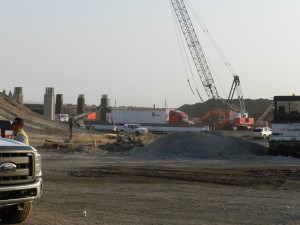
News Item: Bloomberg-Businessweek reported this month that the State of Oregon is piloting a new mileage-based tax on automobiles. The purpose of the tax is to augment gas tax revenue that has been declining due to more fuel efficient cars. Oregon is working with ten other western states, including California, to come up with a workable program.
The Pilot Program
Mr. James Whitty is the manager of the Oregon State Office of Innovative Partnerships and Alternative Funding. His office has implemented a pilot program consisting of about 5000 participants who have agreed to pay 1.5 cents per mile driven in exchange for a refund of Oregon state gas tax paid at the pump.
The intent of the program is to increase tax revenue in order to fund road improvements and maintenance. As currently configured, the pilot program excludes trucks and other vehicles already subject to special taxes. The pilot program captures new tax revenue from electric vehicles, while increasing revenue from vehicles that use gasoline. The program eliminates the incentive of lower gas taxes for driving high mileage vehicles and the tax free status granted to electric vehicles, but does not affect other incentives in the state and federal tax code. High mileage vehicles still enjoy lower costs of gasoline per mile driven. The program taxes all vehicles by the mile equally, assuming that all non-truck motor vehicles cause the same amount of wear and tear on roadways.
The program does not have any lifeline exclusion for low income drivers or baseline mileage exclusion for those who drive very little. All participating motor vehicles pay the same tax per mile.
The mechanics of the pilot program are simple. The driver can choose to use a GPS to report miles driven within the State of Oregon or self-report manually. The advantage of GPS is the driver need make no reports to the state and need not apply for a tax refund for miles driven out of state, assuming that the GPS can differentiate between in-state and out-of-state travel. If the driver chooses not to report using a GPS device, then he must manually keep track and report mileage and apply for refund of excess tax paid for miles driven out of state.
Mr. Whitty indicated that a private contractor collects the data and taxes for the program and remits funds to the state. The cost of administration is relatively high for the pilot program. However, the cost per participant will drop below 5% of gross revenue when the program goes state wide, with a participation rate of over one million vehicles. As long as the rules of the tax law are not too complicated, the administration of the program will eventually be cost effective.
California is Looking to Impose the Tax
Mr. Whitty has been providing California officials with information about the pilot program. Each state that decides to impose the tax can set up its own program. Ultimately, lawmakers will have the final say as to the parameters of the new tax law.
When Oregon’s pilot program is successful, Oregon will probably decide to roll it out statewide. At that point, California is expected to look closely at the results of the pilot program and then decide which aspects of it to adopt. California could decide to adopt all or part of it. Given California’s need for a substantial improvement in highway maintenance and infrastructure, the odds are high that state lawmakers will adopt it, with any number of possible variations.
Depending on how California decides to implement the mileage tax, Valley citizens could be adversely affected to a greater extent than other parts of the state.
Potential Adverse Impacts on the Valley
If California decides to impose the tax from mile one of the drive, low income drivers will be subject to a regressive tax. They will feel the pain the most as they can least afford to pay more taxes. As the Valley has a large population of low income citizens, the economic pain is obvious.
The Valley has a large number of commuters to the Bay Area. Many commuters drive several thousand miles per month. The mileage tax will hit long distance commuters the hardest. If the mileage tax is high enough, the new tax could encourage shorter commutes; that is, working citizens could be forced to move to the Bay Area to cut costs, undermining the local tax base.
Valley citizens who drive high mileage vehicles such as fuel efficient cars, electric hybrids, and all electric vehicles will probably experience a disproportionately greater increase in total annual taxes for roads as they presently pay the lowest levels of fuel taxes; the new tax will level the tax rate for every vehicle.
California presently diverts gas tax money for projects and services other than road maintenance and improvement. An increase in taxes via the mileage tax will be no guarantee that the Valley will have more money to fix its roads unless the State Legislature writes into the law a provision requiring that all mileage tax collected shall be used for roads in the county in which the tax is collected. Given the legislature’s track record of diversions and disproportionate funding allocations, what is the likelihood of that happening?
